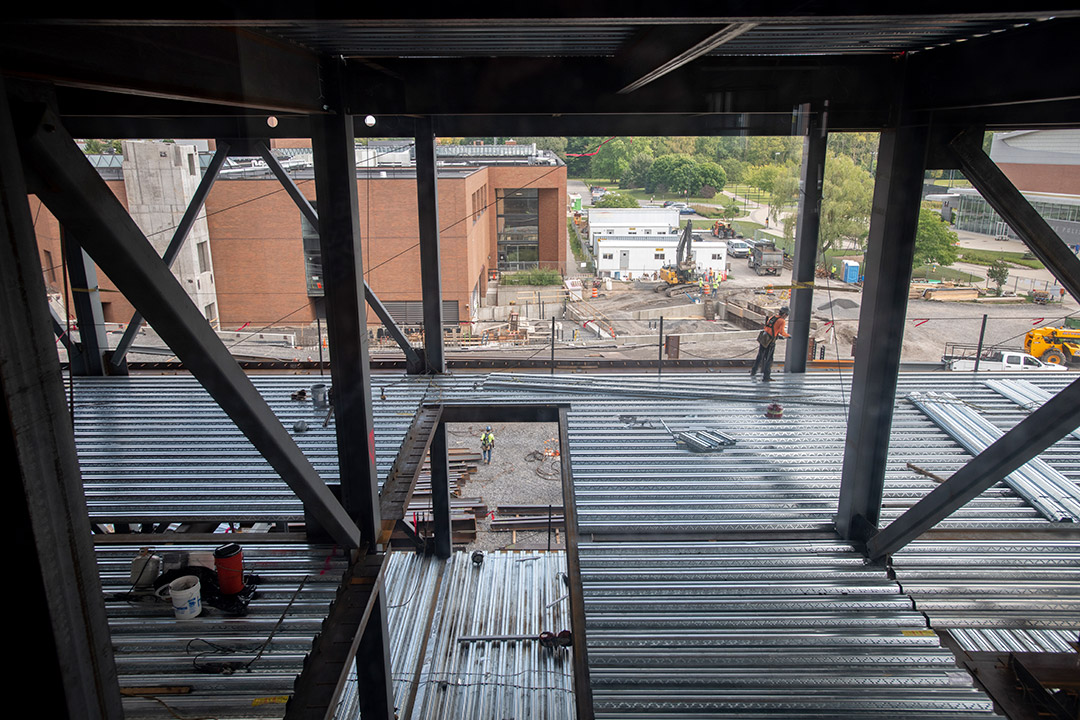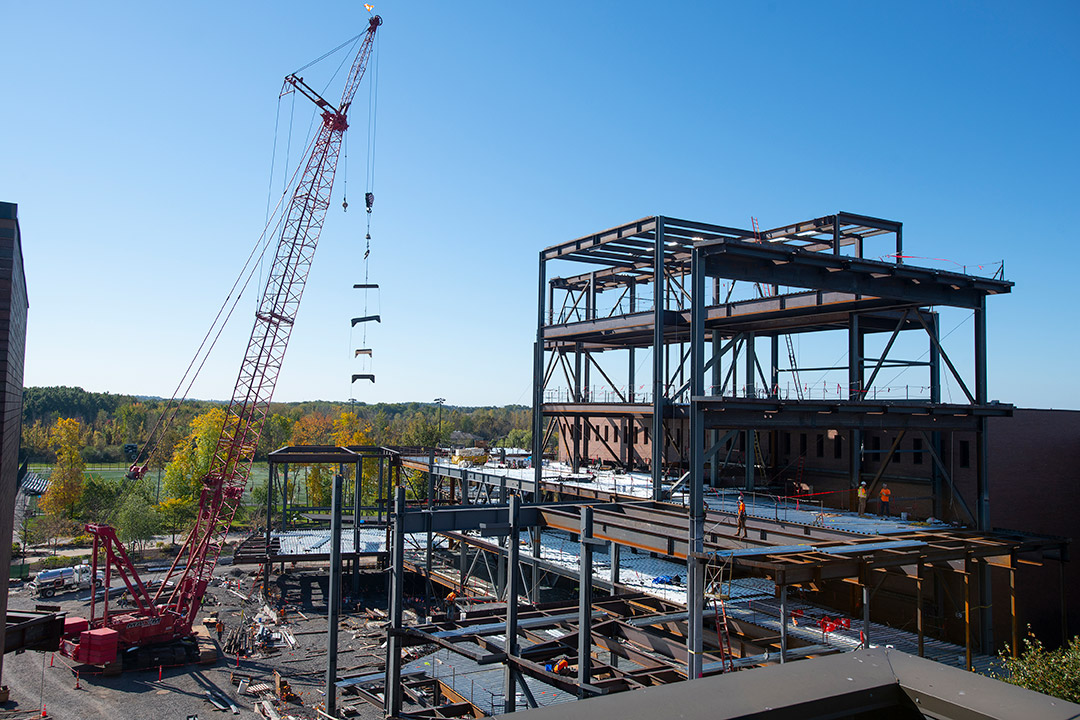Progress continues on makerspace and performing arts complex
A. Sue Weisler
The construction crew has started laying “decking,” the corrugated steel that spans the joists and supports the flooring of the SHED.
The rising steel frame of the makerspace and performing arts complex has transformed the view between Wallace Library and Monroe Hall.
Progress on the steel structure began in the summer and now frames five levels of classrooms capped with a mechanical penthouse on the eastern side of the facility. Work on the skeletal structure also extends south to the dance rehearsal pavilion, jutting toward the transportation circle.
A. Sue Weisler
Work on the Student Hall for Exploration and Development (the SHED) will continue in the winter.
Design nuances of the Student Hall for Exploration and Development (the SHED) will start to make sense to passersby once the steel beams form arcs and the pedestrian bridges add contours, said James Yarrington, university architect and director of Planning and Design Services.
“Right now, you can’t see the curved oval lines that really form the space. That’s coming,” he said.
Despite price hikes in steel and other construction materials and supply chain disruptions, the SHED remains on track to open in fall 2023, according to Yarrington. The project, he estimates, is 20 percent to 25 percent done, the bulk of which includes the early utility work (relocating and reconnecting utility lines), preparing the foundations, and beginning the demolition and renovation in Wallace Library.
Now, the crew has started laying “decking,” the corrugated steel that spans the joists and supports the flooring. The work will continue in the winter inside temporary enclosures kept warm enough for poured concrete to cure.
When complete, the SHED will cover more than 120,000 square feet of new construction independent of renovations in Wallace Library and Monroe Hall. The renovated spaces will exceed 83,000 gross square feet. The total project will exceed 200,000 gross square feet of combined renovated and new space, Yarrington said. The footprint will include natural spaces, a courtyard, and landscaped passages weaving through the building and under a bridge.
RIT trustee and alumnus Austin McChord’s record $50 million gift to RIT in 2017 helped fund the complex that will redefine the campus. The SHED is intended to facilitate collaboration among students using the makerspaces, working on project teams, and participating in performing arts groups, and among those who use the makerspaces.
The building will house individual rehearsal spaces, a large dance instruction studio, and a music rehearsal studio. A black-box/glass-box theater seating 180 will be reconfigurable to control the light entering the facility. Instructional space within the complex will create 27 new classrooms and 1,500 additional seats. These include 22 standard-size flexible classrooms and five extra-large classrooms, each seating 150.
The design plans, created by Boston-based William Rawn Associates Architects Inc., have changed little during the last year, Yarrington noted. As final details continue to evolve, new developments have centered on two smaller design projects for the Cary Graphic Art Collection in Wallace Library and a gallery dedicated to RIT’s partnership with the Genesee Country Village & Museum.
“I think one of the great surprises of the project—besides the dramatic geometry and the size of the SHED itself—is Wallace because if you look at the walk-through animations the design team has done, it’s just a completely different building inside Wallace in the best way,” Yarrington said.
The Rochester firm HBT Architects—the current architect of record, which handles construction details—created the new design for Wallace renovations. HBT is also designing the new Cary Collection suite and the RIT-GCV&M partnership exhibition space.
Funding for the gallery comes from RIT alumnus Philip Wehrheim ’66 (business) and his wife, Anne, who endowed the RIT-GCV&M partnership in 2019. The space will showcase university-wide research and scholarship from the partnership.
All of the funding for the project is part of Transforming RIT: The Campaign for Greatness, a $1 billion university fundraising effort, the largest in university history. This blended campaign seeks support from a variety of investors, including alumni and friends, government and corporate partners, and research foundations and agencies.














